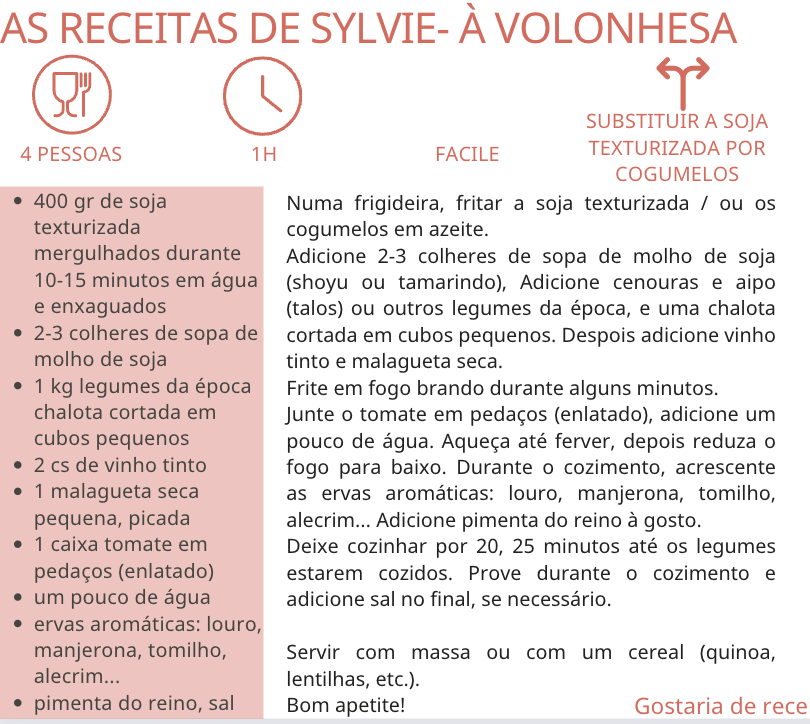
ENGLISH
Recipe
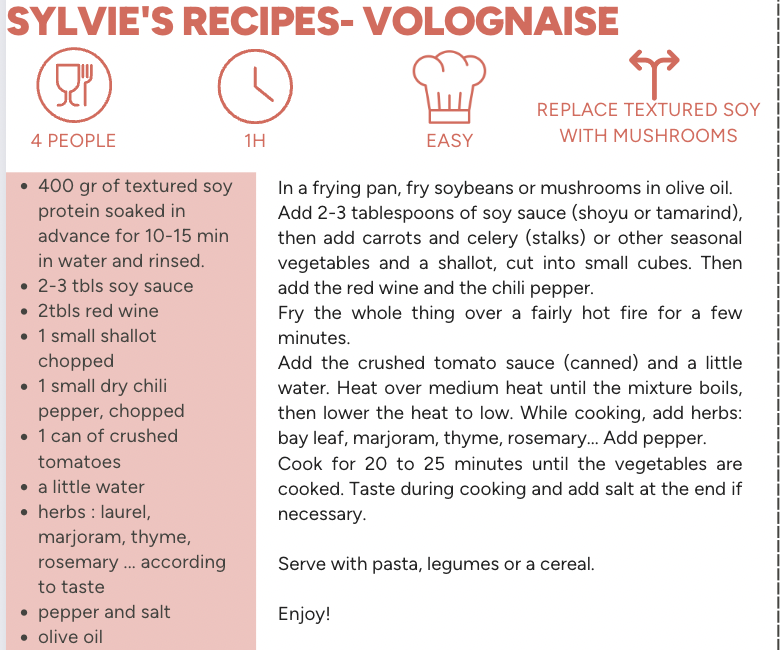

ENGLISH

O Transition Think Tank foi criado em 2021 pela iniciativa de cidadãs e cidadãos que em sua pluralidade de origem, meio profissional, de opinião e gênero querem abrir o debate sobre as necessárias adaptações do sistema atual (econômicas, democráticas, de produção e trocas, sociais, formais e informais) aos limites planetários. Além do sub grupo agricultura-alimentação, ele reflete e trabalha sobre as temáticas “alojamento” e “mudança sistémica”.
No TTT Agricultura – Alimentação nós somos consumidores-as, agricultores-as, educadores-as, cidadãos-ãs aue se preocupam com a forma com que o sistema econômico trata a alimentação. Esta deixa de ser vivida como um direito fundamental e passa a ter o papel de mercadoria visando unicamente o lucro.
Previlegiando uma lógica de reflexão-ação, o TTT se debruça atualmente sobre as seguintes questões: o direito à uma alimentação de qualidade para o conjunto da população é um projeto que podemos construir juntos e aqui? Poderíamos investir coletivamente na necessária transformação e adaptação de nosso sistema agrícola e alimentar para fazer face aos desafios atuais e futuros: mudança climática, restauração da biodiversidade, remuneração justa dos produtores-as / trabalhadores-as, alimentos sãos e acessíveis para consumidores-as, desenvolvimento de uma agricultura regenerativa, preservação das paisagens, preservação dos recursos hídricos?
A reflexão é permanente e o coletivo cuida de suas sementes. Se elas germinam bem conduzirão em ações que, nós esperamos, contribuirão, à sua escala, para a transição agrícola e alimentar.
Nós estamos redigindo atualmente uma petição aos dirigentes políticos. Para concebê-la nós parcitipamos de diferentes atividades com objetivo de abrir o diálogo com o maior número de pessoas possíveis para construção coletiva do texto e a mobilisação entorno do mesmo.
Quer saber mais? Entre em contato conosco: TTTagri@cell.lu
ENGLISH
The Transition Think Tank was created in 2021 on the initiative of citizens who, in their variety of origins, professional backgrounds, opinions and genders, want to open the debate on the necessary adaptations of current systems (economic, democratic, production and exchange, social, formal and informal, etc.) to planetary limits. In addition to the sub-group agriculture – food, it reflects and works on the themes “housing” and “systemic change”.
In the Agriculture – Food DTC we are consumers, farmers, educators, citizens who are concerned about the treatment that the economic system gives to food. The system stops access to healthy food being livedas a fundamental right and takes the role of a commodity, aiming only at generating profit. Favoring a logic of reflection-action, the DTC is currently considering the following questions: ‘Is the right to quality food, for the whole population, a project that we can build together and here?’ ‘Could we manage to invest collectively in the necessary transformation and adaptation of our agricultural and food system in order to face the current and future challenges of: climate change, restoration of biodiversity, fair remuneration of producers/workers, healthy food and accessibility for consumers, development of a regenerative agriculture, preservation of the environment, etc.landscapes, and preservation of water resources?’ This reflection is ongoing, and the collective takes care of these seeds. If they are well germinated, they will lead to actions that, we hope, will contribute, at our scale, to the agricultural and food transition. We are currently drafting a petition to political leaders.
In order to design it, we are participating in different activities to open the dialogue with as many people as possible for the collective construction of the text and the mobilization around it. Want to know more?
Contact us at TTTagri@cell.lu
Geneviève Jadoul por Collectif Citoyen pour le Climat, para ampliar acesso à uma alimentação vegana (grupo Consumo Orgânico e Local)
Queremos motivar os restaurantes a oferecerem um ou mais pratos veganos nos seus menus.
Muitos restaurantes já oferecem opções vegetarianas.
No entanto, sendo a indústria dos lacticínios tão cruel e prejudicial para o meio ambiente quanto a indústria da carne, cada vez mais pessoas estão a tentar reduzir o seu consumo de produtos animais e gostariam de ver mais opções veganas nos restaurantes.
Levando-se em conta também que os pratos veganos podem ser consumidos não só por veganos, mas também por vegetarianos, pessoas intolerantes à lactose e não carnistas, os restauradores matariam dois coelhos com uma cajadada só.
Em termos concretos, o colectivo planeia as seguintes acções:
– Identificar os restaurantes que já oferecem e apresentam opções veganas nos seus menus. Esta lista será publicada/postada/divulgada.
– Pedir aos proprietários de restaurantes que já oferecem pratos veganos, mas não se apercebem disso, que acrescentem a qualificação vegana no menu.
– Oferecer dicas e truques concretos aos proprietários de restaurantes, com os quais podem muito facilmente “veganizar” alguns dos seus pratos (por exemplo, removendo ou substituindo um ingrediente).
– Oferecer a nossa ajuda para encontrar receitas ou criar novos pratos veganos que se enquadrem no seu conceito básico.
Desenvolver uma pequena brochura de sensibilização, para acabar com os preconceitos e receios que alguns proprietários de restaurantes possam ter: comida vegana é igual a comida cara, pouco saudável e complicada. A brochura destacará os benefícios nutricionais dos produtos, os benefícios ambientais, bem como a contribuição para o respeito pelos animais.
– Agradecer as boas práticas com cartões postais como prendas.
O objectivo das nossas acções não será repreender, nem pedir aos proprietários de restaurantes que mudem o seu conceito ou reformulem o seu menu. A ideia é sensibilizar, motivar, apoiar e orientar.
Mais escolha equivale a mais clientes… todos ganham!
Venha participar de nosso coletivo:
adriana@transition-minett.lu
Let’s turn to the reusable!
Citizens, let’s put an end to the disposable – LET’S TALK 🤝 about the reusable options ♻️ that exist in our SHOPS and RESTAURANTS, ♻️ like the Ecobox https://ecobox.lu/fr/ and Spin cup https://www.valorlux or Luloop (https://www.luloop.lu/).
Luxembourg has adopted a Zero Waste strategy (Null Offall) encouraging the reduction of waste since 2020. Since 2023, ⚠️REUSABLE tableware is MANDATORY for meals consumed ON SITE in restaurants.⚠️
La Mesa, Maison de la Transition, operates in a system that is as Zero Waste as possible.
We encourage our consumers to bring their own containers, cups or tupperware. This reduces:
– Trash
– Food waste.
Interested in the process? You will find ECOBOX information flyers at Mesa.
You can also write to us at: yasmin@transition-minett.lu
Out of about fifty registered participants, more than seventy-five people came to participate in the launch of the Collectif Citoyen pour le Climat in Ellergronn on Saturday. These citizens came to express themselves, to exchange, and to build collectively, in a warm and benevolent atmosphere, the future of Esch-sur-Alzette.
Twelve thematic workshops allowed the people of Esch to meet and reflect together on food, energy, economic, urban and civic issues by drawing the beginnings of a desirable and sustainable future for Esch. Each working group has given itself a date to continue to exchange and build together, the continuation promises to be at least as rich as the day of December 3!
https://www.transition-minett.lu/events/
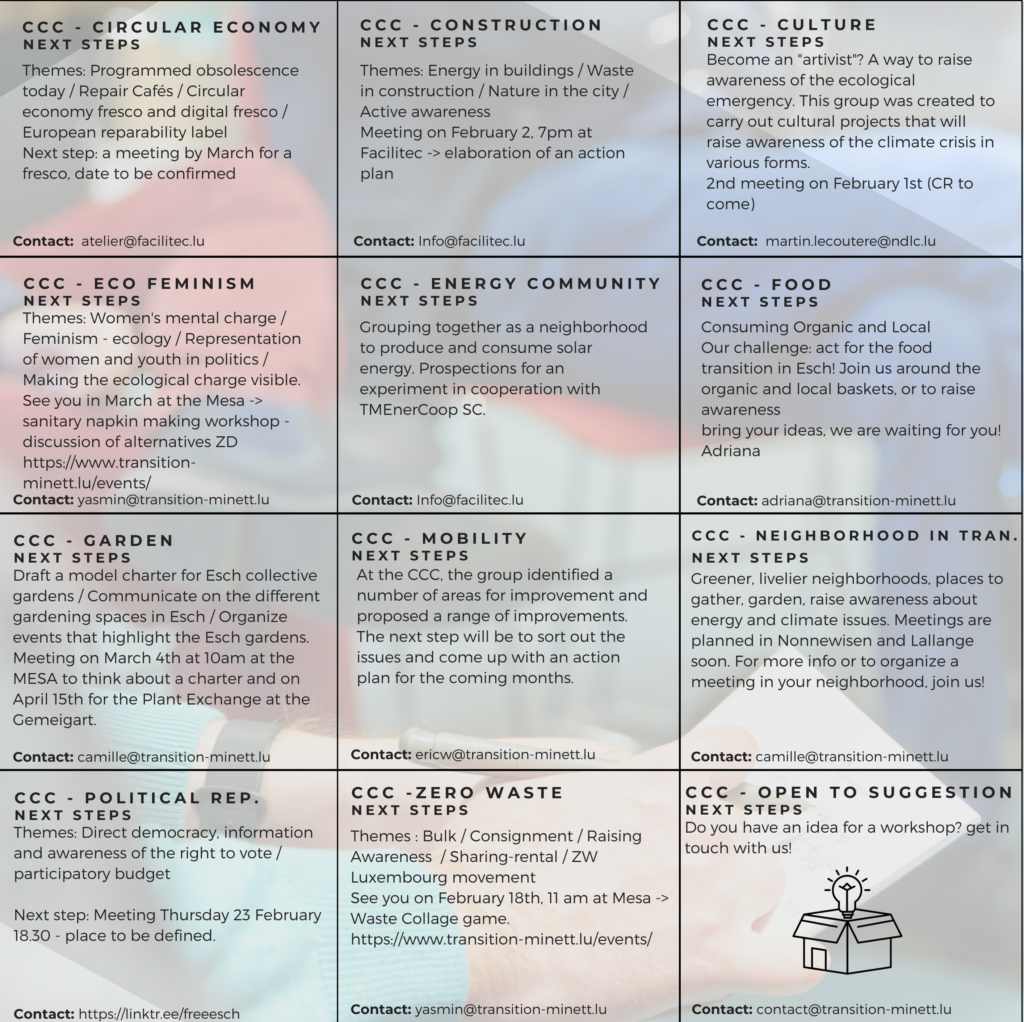
Cerca de cinquenta pessoas se inscreveram, mais de setenta e cinco vieram participar do lançamento do Coletivo Cidadão para o Clima no Ellergronn. Estes cidadãos vieram expressar-se, trocar, e construir colectivamente, numa atmosfera calorosa e acolhedora, o futuro de Esch-sur-Alzette. Doze oficinas temáticas permitiram ao povo de Esch encontrar-se e reflectir em conjunto sobre alimentação, energia, questões econômicas, urbanas e cívicas, desenhando os inícios de um futuro desejável e sustentável para Esch. Cada grupo de trabalho deu-se uma data para continuar a trocar e construir em conjunto, a continuação promete ser pelo menos tão rica como o dia 3 de Dezembro!
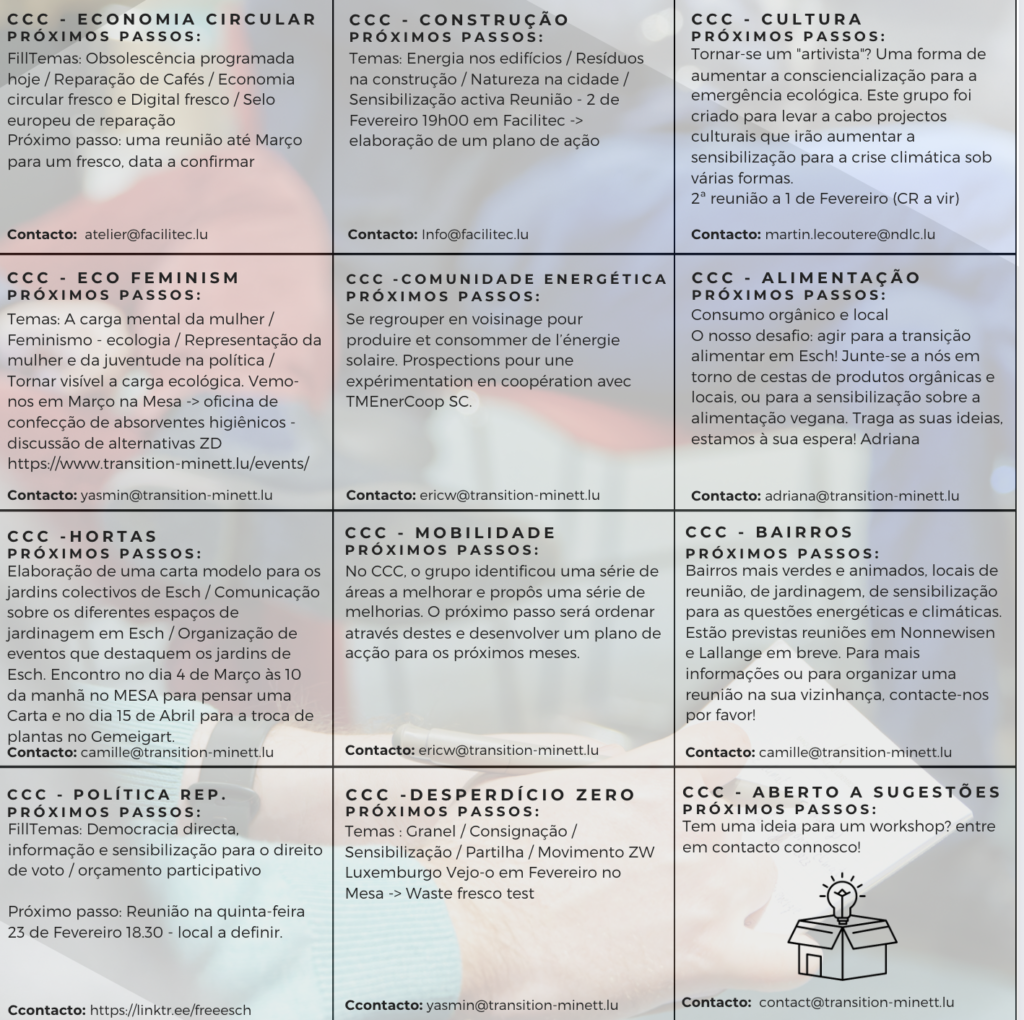
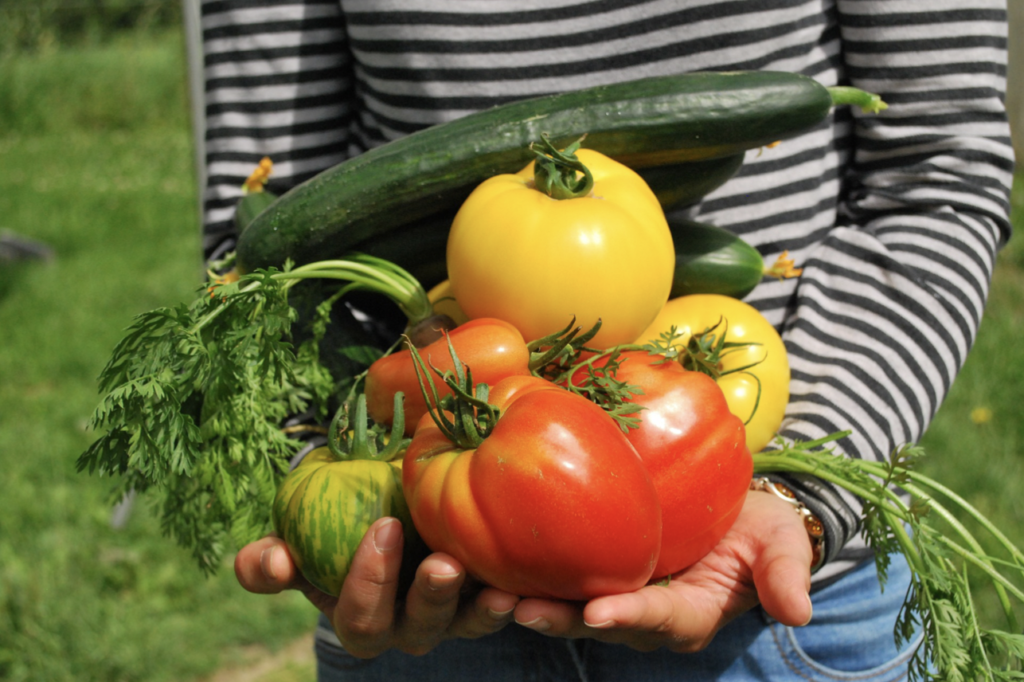
Lilia Hassouna
Photo credit: pixabay.com
We live in an age where almost everything we need arrives at our doorstep. We often forget that the food we consume goes through a long journey that sometimes starts at the other end of the world. The health crisis we have just experienced reminded us that the breakdown of distribution chains can cause delays or even stop the supplies completely. Economic and ecological factors make local production increasingly necessary. Many communities and individuals have committed to growing some or all of their own products. Why not join the movement too? Here are five good reasons to have your own garden in 2023:
1. No garden needed: Almost any crop can be grown successfully in pots, as long as you have a balcony or windowsill with access to light.
2. It’s easy to get started: fortunately, all the information you need to start and maintain a vegetable garden can be found on the internet. One of the best online resources is the Youtube channel “Le potager d’Olivier”. In Luxembourg, a cooperative called “Terra Coop” organizes courses and workshops to learn about organic agriculture. However, the best way to learn is to get your hands dirty, literally.
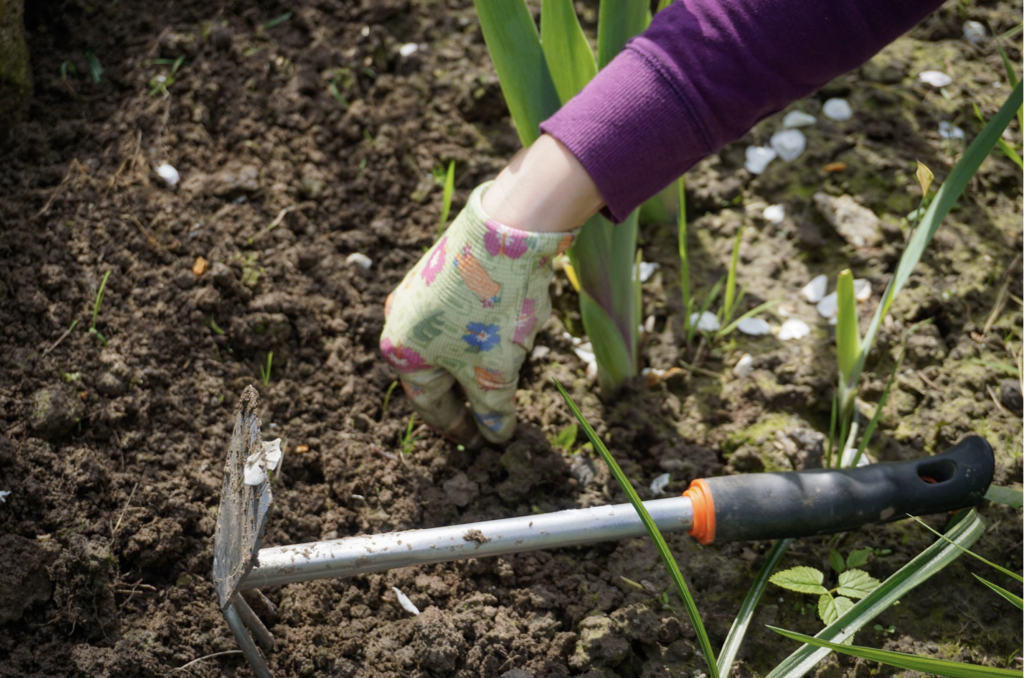
3. Cheap organic products: the harmful effects of pesticides on our health and the environment are well documented, but organic products can be quite expensive. In the garden, a single potato yields an average of one kilogram of potatoes.
4. Participate in the protection of the planet: the transport of foods generates colossal carbon emissions. That’s why picking some of your fruits and vegetables just a few meters away from your home reduces your carbon footprint and the planet will thank you for it.
5. Enjoy the benefits of gardening: finally, gardening has many health benefits, including reducing stress, fighting sedentary diseases and even strengthening bones. This is due on the one hand to the physical work involved and on the other hand to the therapeutic virtues of contact with the earth and greenery.
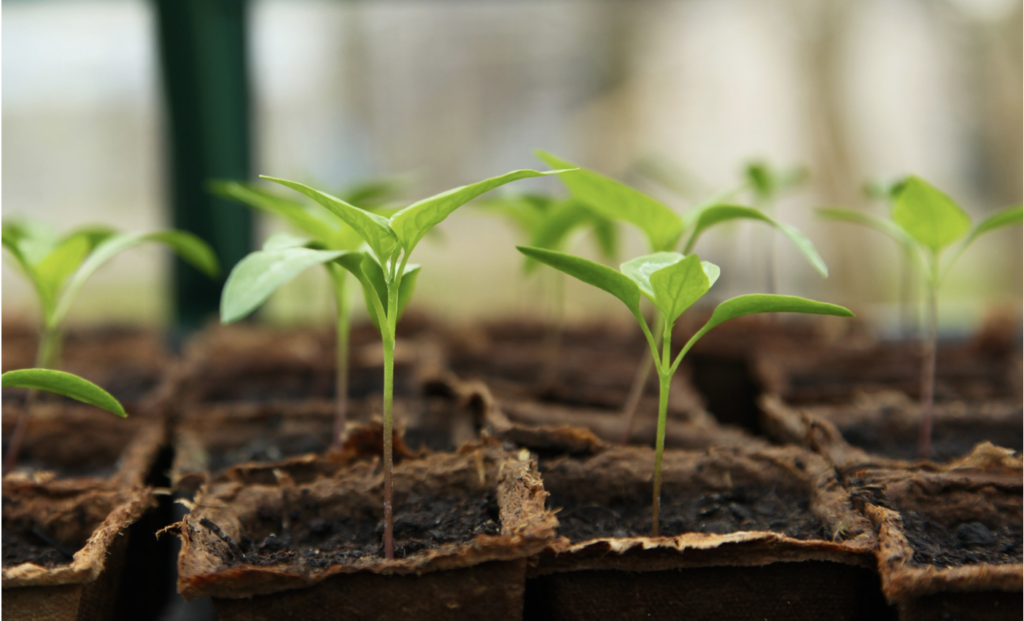
—
If you want to join a collective garden in Esch, and enjoy a space to meet neighbors, produce vegetables and fruits together, learn gardening techniques in a friendly atmosphere, there are 7 collective gardens in Esch. They are located in the districts Centre (Jardin Bredewee), Deleight (Jardin Rose des vents), Brill (Jardin Cockerills), Lallange (Jardin des 4 coins du monde), Belval (Gaart Belval), Neudorf (Jardin de la Piaza B4), Nonnewisen (under construction, for more information contact@transition-minett.lu). Find all the information and contacts of the gardens in Esch and all over Luxembourg on the website https://eisegaart.cell.lu/jardins/.
Vivemos numa época em que quase tudo o que precisamos chega à nossa porta. Esquecemo-nos frequentemente que a comida que consumimos passa por uma longa viagem que por vezes começa no outro extremo do mundo. A crise de saúde que acabamos de viver lembra-nos que a ruptura das cadeias de distribuição pode causar atrasos ou mesmo paragens no abastecimento. Factores económicos e ecológicos tornam a produção local cada vez mais necessária. Muitas comunidades e indivíduos comprometeram-se a cultivar parte ou a totalidade dos seus próprios produtos. Porque não aderir também ao movimento? Aqui estão cinco boas razões para ter o sua própria horta em 2023:
1. Não é necessário ter um terreno : quase todo cultivo pode ser feito com sucesso em vasos, basta uma varanda ou uma janela com acesso à luz.
2. É fácil começar : felizmente, toda a informação de que se precisa para começar e manter uma horta pode ser encontrada na Internet. Um dos melhores recursos online é o canal do Youtube “Le potager d’Olivier”. No Luxemburgo, a cooperativa “Terra Coop” organiza cursos e workshops para quem quer aprender sobre agricultura biológica. Contudo, a melhor maneira de aprender é sujar as mãos, literalmente.
3. Produtos orgânicos baratos: os efeitos nocivos dos pesticidas sobre a nossa saúde e o ambiente estão bem documentados, mas os produtos orgânicos podem ser bastante caros. No jardim, uma única batata produz, em média, um quilograma de batatas.
4. Participar na protecção do planeta: O transporte de alimentos gera emissões colossais de carbono. É por isso que cozinhar frutas e legumes cultivados por você a poucos metros de distância da sua casa reduz a sua pegada de carbono e o planeta vai agradecer-lhe por isso.
5. Desfrute dos benefícios da jardinagem : finalmente, a jardinagem tem muitos benefícios para a saúde, incluindo a redução do stress, o combate a doenças sedentárias e até o fortalecimento dos ossos. Isto deve-se por um lado ao trabalho físico envolvido e por outro lado às virtudes terapêuticas do contacto com a terra e o verde.
—
Se você quiser se juntar a um jardim coletivo em Esch, e desfrutar de um espaço para conhecer vizinhos, produzir vegetais e frutas juntos, aprender técnicas de jardinagem em um ambiente amigável, existem 7 jardins coletivos em Esch. Eles estão localizados nos distritos Centro (Jardin Bredewee), Deleight (Jardin Rose des vents), Brill (Jardin Cockerills), Lallange (Jardin des 4 coins du monde), Belval (Gaart Belval), Neudorf (Jardin de la Piaza B4), Nonnewisen (em construção, para mais informações contact@transition-minett.lu). Encontre todas as informações e contatos dos jardins em Esch e em todo o Luxemburgo no site https://eisegaart.cell.lu/jardins/.

Eric Lavilluniere For the team of Transition Minett asbl
“Be careful, it’s hot!” announces Jean-Alain who, while bringing the turkey he cooked, proudly announces that he got it from the farm in the North of the country to support local farmers. “Yes, okay, but you to get it you went with your SUV that pollutes a lot” comments Aline, who is coming back from the University of Brussels. “And it’s not even organic” adds Julien who just got a job at the ADEM. “Anyway, we should be vegan” adds Jemp, Anita’s new boyfriend, “if we really want to have a sustainable future on this planet”. “Yes, I saw a series on Netflix that explains well that if we eat gluten-free and heat with wood we decrease the production of CO2 that destroys the ozone layer “*, adds Alice the prankster. “But watching a movie on a streaming platform is also very bad for the planet: look I printed the link my sister sent me by email”. “But you’re crazy to print, it just adds to the waste and deforestation disaster… Although storing on a cloud isn’t great either!” “I’m going to plug in my car to charge it,” says Auntie Claudine, who lost her appetite from all this discussion. “And yes, I know, my battery contains rare metals and the solar panels on my roof are up for discussion. Are all our efforts really going to help anyway?” “Look outside, it’s snowing!” shouts Granny Jeannette who was dreaming… In this scene, illustrating a holiday meal – a bit of a caricature, I agree- (sic) each sentence represents discussions we have with family, friends or colleagues.
It teaches us that 1) if this has become a subject of discussion, it is because we are beginning to realize that our model of life is outdated, 2) that there is no ready-made solution. I agree that it is a bit of a caricature (sic), but every sentence of it is a rhythm of our discussions with family, friends or colleagues. It teaches us that 1) if it has become a subject of discussion, it is because we are starting to realize that our life model is outdated, 2) that there is no ready-made solution but that we must build acceptable compromises, and 3) that even if what we are doing is not enough, it is nevertheless necessary.
What can we do at our level? It is to determine this that we launched Transition Minett 10 years ago and the Collectif Citoyen pour le Climat on December 3rd at the Ellergronn. We cannot sit back and wait for the government or the European Union to do everything. This is the framework that we offer, in association with all the relevant organizations, for all the citizens who want to address the issues. Everyone brings his or her energy, skills and desires. We build and search for solutions together at our level. You will find in the first issue of this newsletter a small overview of the first working groups that started on December 3rd and of the next activities of Transition Minett: from mobility to food, through circular economy or eco-feminism, we have a great diversity of themes. Energy, heating equipment and insulation in our homes is a big topic that we can have an impact on. We intend to make it a priority in cooperation with the Commune. Biodiversity, water quality and pollution are also very important issues and there are collages to make you aware of them (we will come back to this soon).
So don’t hesitate to contact the person in charge. Everything is open to create other themes and actions if you wish. In this letter we also give you some news about our agenda and very soon we will have a new website. So have a good read and …. see you soon.
“A nossa aposta é que todos podem agir, ser criativos, e usar os seus conhecimentos em ações concretas e positivas.”
“Cuidado, olha o quente !” exclamou Jean-Alain que, enquanto trazia o peru que tinha cozido, anunciou orgulhosamente que tinha ido buscá-lo em um sítio no norte do país para contribuir ao consumo de alimentos locais e da roça. “Mas foi buscá-lo com o seu SUV que polui” comentou Aline que chegava da Universidade de Bruxelas. “E nem sequer é orgânico”, acrescentou Julien, que acaba de conseguir um emprego na ADEM. “De qualquer modo, devemos ser veganos”, acrescentou Jemp, o novo namorado de Anita, “se realmente quisermos ter um futuro sustentável neste planeta. “Sim, vi uma série na Netflix que explica que se a gente comer sem glúten e aquecer com madeira a gente reduz a produção de CO2 que destrói a camada de ozônio “*, acrescentou Alice, a piadista. “Mas ver um filme numa plataforma de streaming é também muito ruim para o planeta: veja, imprimi o link que a minha irmã me enviou por e-mail. “Mas é uma loucura imprimir, contribui ainda mais para o desastre do desperdício e da desflorestação… Embora armazenar numa nuvem também não seja grande coisa”! “Vou ligar o meu carro para recarrega-lo”, disse a tia Claudine, a quem toda esta conversa tinha cortado a fome. “E sim, eu sei, a minha bateria contém metais raros e os painéis solares no meu telhado estão abertos à discussão. Será que todo o nosso esforço é mesmo em vão?” “Olhem la fora, está nevando!” gritou a avó Jeannette que estava a sonhar…
Este esquete, que ilustra uma refeição de fim de ano, admito ser um pouco caricatural (sic), mas em cada frase revela o ritmo que tomam cada vez mais nossas discussões em família, entre amigos ou colegas, e ensina-nos que 1) se isto se tornou um tema de discussão, é porque começamos a perceber que o nosso modelo de vida está ultrapassado, 2) que não existe uma solução pronta, mas que temos de construir compromissos aceitáveis e 3) que mesmo que o que fazemos não seja suficiente, é no entanto necessário. O que podemos fazer ao nosso nível? Foi para responder a esta questão que lançamos Transition Minett asbl há 10 anos atrás e o Coletivo Cidadão para o Clima no 3 de Dezembro passado no Ellergronn.
Não podemos cruzar os braços e esperar que o Governo ou a União Europeia façam tudo. Este é o quadro que oferecemos, em associação com todas as organizações envolvidas, todos os cidadãos interessados. Todos trazem a sua energia, as suas competências e os seus desejos. Construímos e procuramos soluções em conjunto ao nosso nível. No primeiro número deste boletim informativo, você encontrará uma pequena panorâmica dos primeiros grupos de trabalho que foram lançados no dia 3 de dezembro e das próximas actividades de Transition Minett: da mobilidade à alimentação, passando pela economia circular ou eco-feminismo, temos uma vasta gama de temas. A energia, equipamentos de aquecimento e isolamento nas nossas casas é um grande tópico sobre o qual podemos ter impacto. Pretendemos fazer disto uma prioridade em cooperação com o município. A biodiversidade, a qualidade da água e a poluição também são questões muito importantes e existem atividades de sensibilização (voltaremos a este assunto em breve).
Por isso, não hesite em contactar a pessoa de referência. Tudo está em aberto caso queira propor outros temas e acções. Neste boletim você também encontrará novidades sobre a nossa agenda. Muito em breve teremos um novo website. Portanto, tenha uma boa leitura e …. até logo.
* O CO2 é o principal responsável pelo efeito estufa que perturba o clima. Por sua vez os gazes CFC são responsáveis pelo o buraco na camada de ozônio. A emissão destes gazes foi proíbida na Europa e nos EUA, diminuindo assim o buraco na camada de ozônio.

Let’s start with why I decided to write this article
I had already read and heard about some of the impacts caused by fast fashion via Instagram posts or online articles, even saw some short documentaries about it. However, it was mostly after reading this French book ‘’Une mode éthique est-elle possible?’’ by Majdouline Sbai, that I started to get more into this topic. I no longer feel the same way entering a fast-fashion store now that I’m more aware of what goes on in this industry. But I also feel the urge to tell others about it before it’s ”too late” and we no longer can save the planet anymore. Unfortunately, the book is only available in French, but I’d highly recommend it! Before getting into it I would also recommend the documentary ‘’ The True Cost’’ that explores the impact of fashion on people and the planet.
Let’s continue with the definition
You might have heard of many concepts linked to ethical fashion such as up-cycling, local production, eco-design, organic cotton etc… Besides, it is not always called ethical fashion, it can also be called sustainable fashion, eco-responsible fashion, slow fashion, or conscious fashion. But what is ethical? And how is it measured?
There is no concrete definition of this term since everyone has their own vision of what ethical is and isn’t. But in general, it’s a question of operating according to moral values: respect for people, the planet and of oneself, aiming to reduce the negative impact on all three.
Ethical brands do their best to be more transparent and can answer questions such as ‘’where is the garment produced? What are its components? Are they pesticide-free? What are the conditions of its manufacturing?’’ – unlike fast fashion brands. However, In the end it’s really more about values rather than rules and each ethical fashion player, regardless of agreeing with each other on the term ‘’ethical’’, always goes in the same direction: a less destructive fashion for humans and the environment.
What if I told you that you could be fashionable and help the environment at the same time?
The rate at which we’re using resources isn’t sustainable for our planet, nor is it necessary. If we want to have a positive impact on our environment and continue existing on this beautiful planet, we need to address this issue now, because at the pace we’re currently going, we won’t be able to in the future anymore.
We should bother with ethical fashion, because as said Mahatma Ghandi, “there is no beauty in the finest cloth if it makes hunger and unhappiness.”
What is the solution?
Switching our consumption habits to more sustainable and ethical ones is a difficult process. Especially, since we live in a consumerist society and seem to be stuck in a vicious cycle, basing our life on consumption. In addition, for the first time in history, the global environmental and social problems, but also the solutions, seem to be beyond our understanding and out of our reach.
Frankly, there is no such thing as the perfect solution. Instead, there are plenty of interesting alternatives, each presenting their own advantages and disadvantages. Let’s go through a few different facets of ethical fashion that will help you form your own opinion and guide you to do your part.
What is the problem of today’s fashion or also called ‘’fast fashion’’?
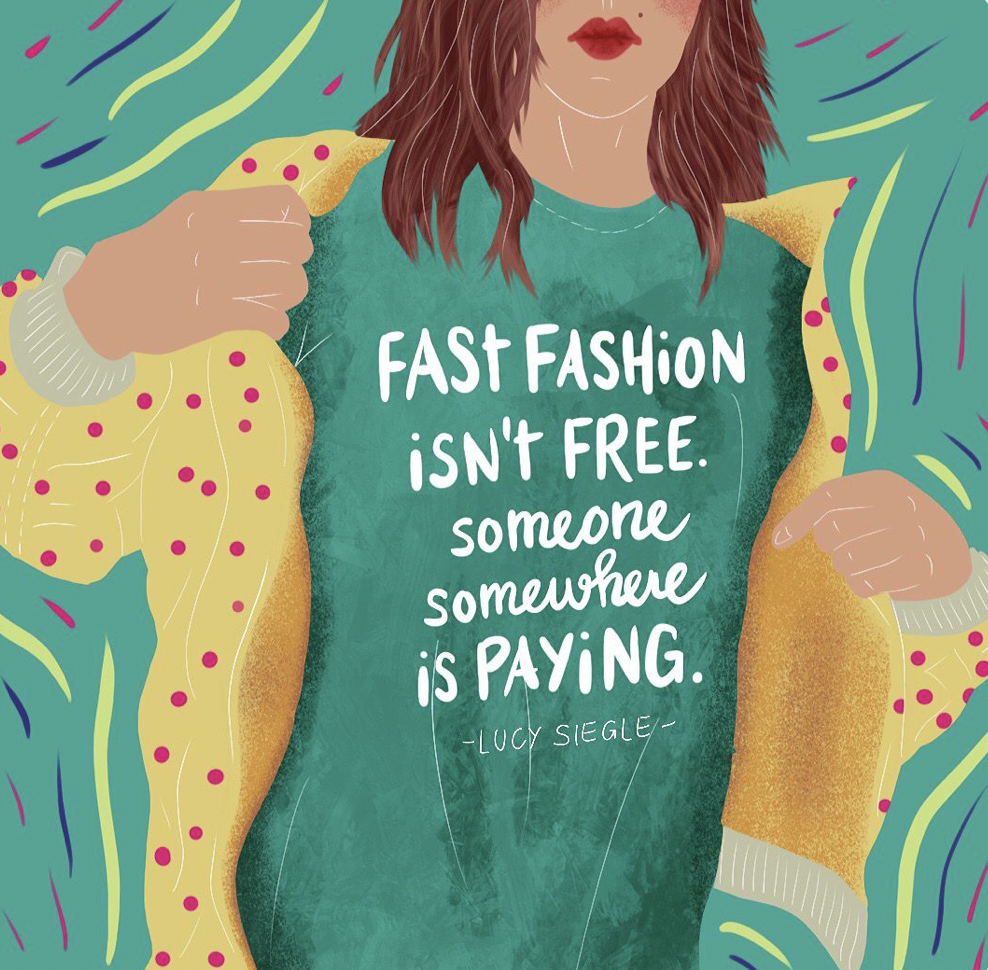
For the last 20-30 years, the fashion design and manufacturing process has become extremely complex. To the point that today, big and small fashion brands seem to be unable to identify and to control their entire production chain.
Fast fashion has now become the dominant model in the fashion industry. The whole concept is about producing in a record time, constantly renewing collections, permanently offering new products in physical stores or online, and encouraging more frequent purchases. By doing so, 140 billion pieces of clothing are being produced worldwide each year.
And while 20 years ago distributors only offered two ready-to-wear collections per year: spring/summer and fall/winter, they have now gone to 52. For this to work, fashion needs to be disposable, and the goal is therefore to buy more, cheaper, for lower quality clothing which at the same time uses low-cost labor to meet this low-price requirement.
All of this has been happening over the past decades, without considering the garment workers’ human rights or even the horrific environmental impacts it is causing. The volume of production, the low financial means devoted to manufacturing, the rhythm of the collections and the permanent sales are what make fast-fashion unsustainable today.
With so many aspects to tackle, we might feel overwhelmed or discouraged to start our ethical fashion journey. Faced with such complexity, it’s good to remember that even though there’s no global solution, there are thousands of local solutions, and we must never forget that small changes end up making a big difference.
Let’s start from the beginning of each garment
One of the biggest differences between ethical fashion and fast fashion lies in the production process and in the thought given to the lifespan of the garments. While fast fashion is focused fabric and promotes fashion that’s less destructive for us and the environment. The wages of the people who produce the material are also considered in the ethical fashion process.
Ethical fashion and textiles
Our clothes are made from many different fabrics, but the 2 main categories are ‘’natural fibers’’ and ‘’synthetic fibers’’.
Natural fibers exclude synthetic fibers and are obtained from nature (ex: linen, cotton, silk, wool, hemp, cashmere). However, we need to be careful if their origin is natural, because they can be produced intensively and have a significant impact on the environment. The best-known case is cotton alone, which consumes 1/4 of the planet’s pesticides. Nevertheless, the advantages of these fibers are:
Synthetic fibers are completely manmade and essentially made from plastic (ex: polyester, nylon, lycra). More than 60% of clothes are made with synthetic textiles derived from oil, like nylon but mostly polyester.
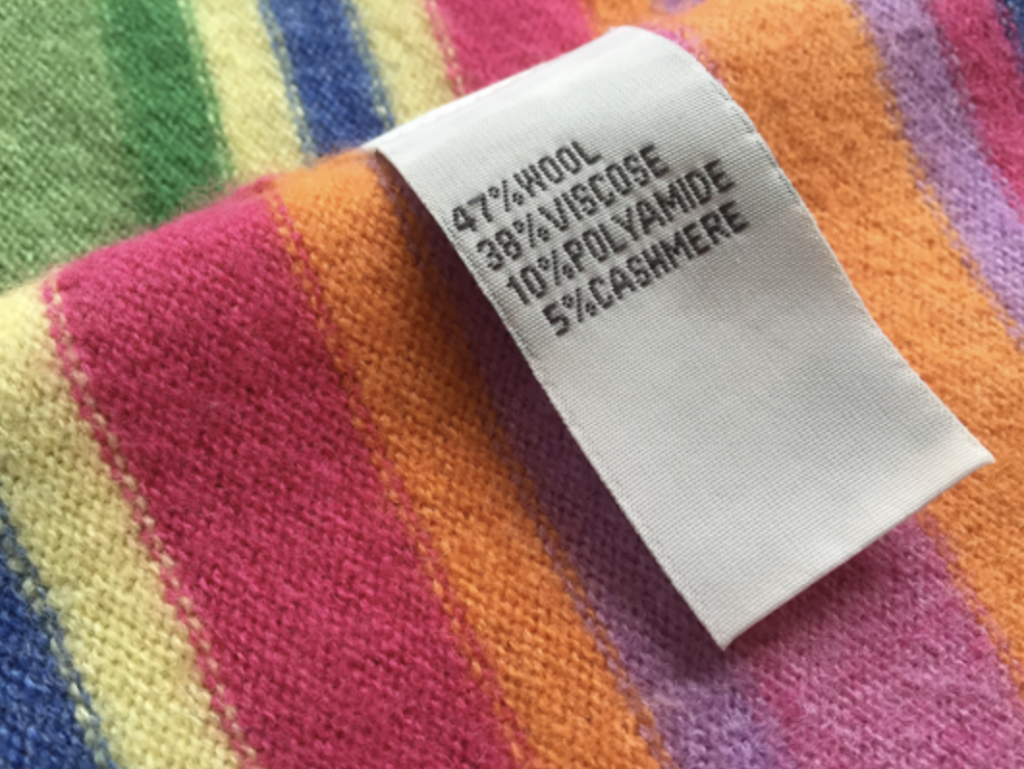
The fashion brands love them because they are cheap, durable and easy to adapt to many purposes. But those synthetic fabrics shed large amounts of microfibers, especially when machine washed, but also while being manufactured, and even just worn. Which is another problem the poor quality of fast fashion items is causing us.
Since plastic isn’t biodegradable, these synthetic fabrics release ‘’microplastics’’ often invisible to the naked eye into the air and our wastewater systems, and from there arrive into our rivers, lakes and oceans. For instance, Lake Geneva, the biggest lake in Europe, is almost as polluted as the ocean with micro-plastics, causing huge environmental issues.
In short, ethical fashion considers the impact of using materials to make clothing. Linen, cotton, polyester, denim; each fabric has a different impact on the planet and its people. It is therefore important to carefully choose what our clothes are made from and of course to prioritize natural fibers over the synthetic ones and preferably organic to avoid pesticides. Choosing the lesser impact is what ethical fashion is all about.
Ethical fashion and tailoring
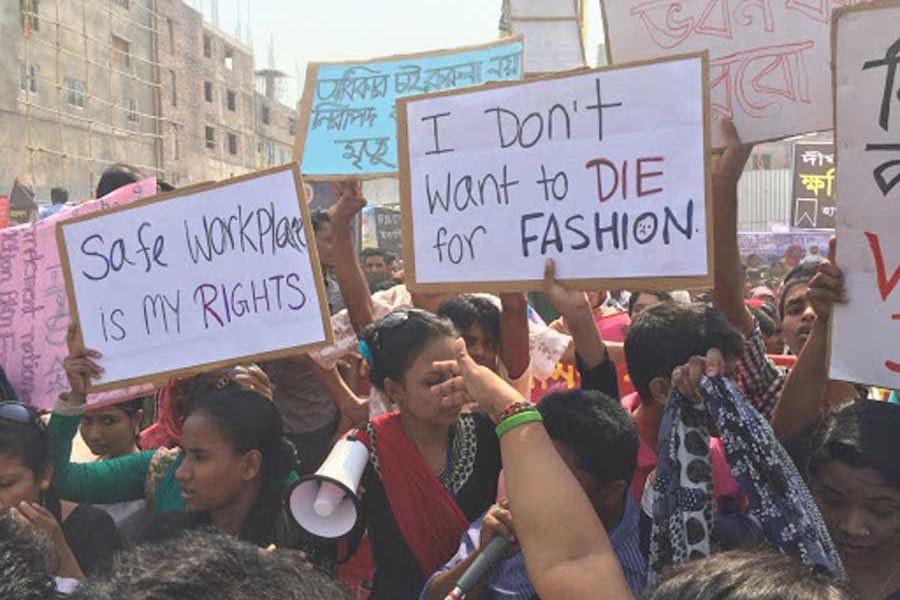
As mentioned before, this is a sector where there is massive violation of human rights at work. Fast fashion is responsible for the abuse and exploitation of not only the planet’s natural resources, but also the people who make our clothing. 1 in 6 people work in the global fashion industry, and most are earning less than $3 a day. Exploited, underpaid and put in terrible working conditions, is what these people go through every single day. Basic rights such as access to clean drinking water or decent temperatures inside the factories, is unknown to them. Even though the Rana Plaza tragedy in 2013 (killing at least 1,132 people and injured more than 2,500) forced the world to recognize the wickedness of the fashion industry, the problem remains the same years later.
We should bother with ethical fashion because we’re all human. The emotional and mental stress of a cotton farmer and the conditions of garment factory workers wouldn’t be wished to anyone, so let’s take them in consideration. The tragic event of the Rana Plaza should have never taken place and serves as a cruel reminder as to how important ethical production is.
There are many aspects that can make the production of garments more ‘’ethical’’ In terms of tailoring. Let’s go through some ethical fashion concepts.
Fair trade manufacturing:
Fair trade clothing responds to the problem of non-respected workers in this sector. While 430 million are thought to work in fashion and textile production worldwide, these jobs are often badly paid, physically difficult, devalued, with few or non-existing security conditions and offer no prospect of development. Fair trade clothing responds to this problem by committing to respecting labor standards.
Made In Local:
Made In Local is generally made in France and on the rise now, but faced with the difficulties of finding all the appropriate suppliers locally, it sometimes turns into made in Europe. In this case, we are not talking about fair trade since French and European labor standards are already very high and are most probably respected since there are more frequent controls. The goal of this concept is to relocate certain industrial activities in our consumer countries, making it possible to recreate local jobs and limit polluting emissions linked to transport (although the raw material, the fabric/fiber often still come from the other side of the planet).
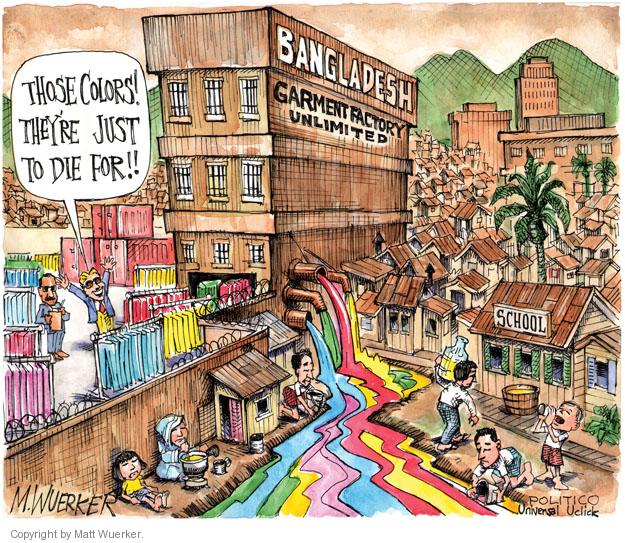
Dyes:
However, the general method within the fast fashion industry is dyeing clothing with chemicals and pollutants to give them that perfect shade of pink, orange, or whatever is “on trend”. Also, did you know that in China, they say you can tell the popular color that season by the color of the rivers?
And while we’ve swapped to easier, cheaper, and brighter colors that bring along a bunch of disadvantages, most of them are fabricated in developing countries with no regulations. Even if certain standards exist, there is no effective means of control. As a result, pollutant emissions are increasing exponentially every year, flowing into water ways, contaminating drinking and bathing water of surrounding villages.
The repercussions of irresponsible dye use may lead to stillbirths, mutations, and other life changing conditions, along with the destruction of plant life and ecosystems. The disadvantages of these dyes, such as environmental pollution and human health, have long been neglected.
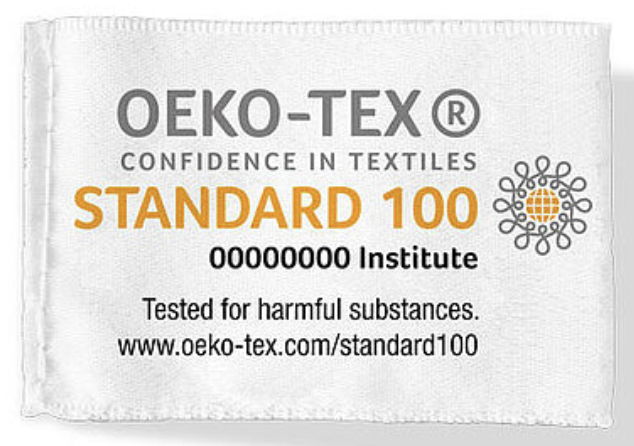
To not participate in this, you can buy ethical fashion which focuses more on ethical dyeing processes. These dyes have often been replaced by natural ones (certifies the absence of the 100 most dangerous pollutants), recycled dyes, or even better no color change at all. The price to humanity and the environment of conventional dyes and processes just isn’t worth it.
But why is ethical fashion expensive?
Ethical fashion is usually pricier because the whole concept is the exact opposite of fast fashion that we have gotten so used to. The whole process is taken into account: from the materials used to the wage the garment workers were paid to create the garment – that’s what ends up costing it a bit more. The respect towards garment workers who are well-paid and fairly treated, the preservation of the environment by using better cotton or carbon neutral shipping service to import garments, or simply the fact that we wrap our body with these natural and more sustainable garments is definitely worth the price they come with.
Any ethically-made garment should be viewed as an investment. It is made to last, unlike fast fashion clothing. When you pay for an ethical and sustainable piece of clothing, you are investing in each individual time you will wear it, a concept called “cost per wear”. (Cost per wear describes the price you pay for a garment, divided by the amount of times you wear it. For instance, if you buy a garment for $100, and wear it 4 times, that garment cost you $25 each time you wore it. So, if you end up wearing this item once a week, in one year you will bring the cost per wear right down to $1.92307692308 – less than half of the price of your daily coffee.)
Start your own ethical fashion journey!
Globally, an estimated 92 million tons of textiles waste is created each year. The equivalent to a rubbish truck full of clothes ends up in landfill sites every second. Let’s see what we as consumers can do to reduce this number and how to adapt a more ethical fashion.
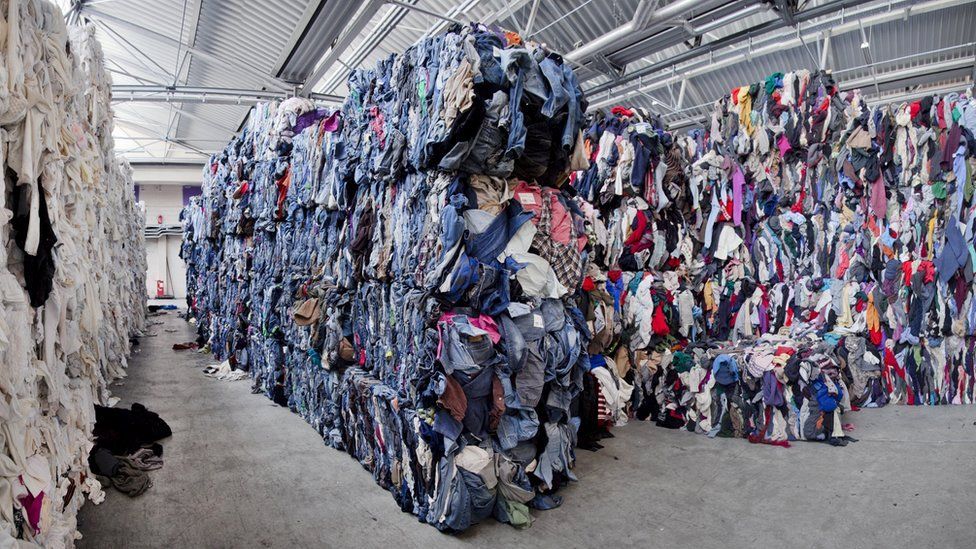
1. Change the way you consume: from having to being
Joining an association, educating yourself and choosing more durable clothes is already a big step, but to have a profound change, we must question our relationship with objects. We live in a consumerist society, and we have been consciously and unconsciously programmed to consume as much as possible. That’s why when we buy clothes, we should ask ourselves: “Does this meet a well-considered need or am I simply looking for happiness, well-being?”, ”Don’t I already have something similar?”.
Once we realize our overall volume of consumption is depleting natural resources, but also that the employees who produce it are being exploited, we can reflect better on our environmental and social impacts for each act of purchase and allows us to stop over-consumption.
2. Get back to basics
Stop buying these temporary trends and start buying trend-defying basics. This could be a pair of quality-made denim jeans, or a timeless ethically made top or a jacket that has been designed for versatility and durability. Buying basics and staple pieces for your wardrobe will save you a lotof money in the long run.
3. Choose your clothes well and take care of them
Finding your style is very important and useful, because if we feel good in our clothes, we’re less likely to get rid of them. As a result, we buy less and keep items longer.
We are often seduced by the major trends of a season or an era, that we end up forgetting that everything doesn’t suit everyone. We must therefore try to identify the clothes that give us the feeling of being true to ourselves. To find these clothes, they must be adapted to our mode of existence. What are my days made up of? What is my job? What is the climate? How do I move? These questions should be answered before choosing.
To keep your clothes the longest time possible, you must follow the instructions on the care label (how to wash, dry etc.; air drying clothes is of course the most ecological alternative).
4. Repair, Recycle, Rewear, Resell
Even if we adopt a more responsible consumption or the “Zero Waste” approach, we sometimes will still need to say goodbye to a piece of clothing. Instead of simply throwing it away, here are some alternatives to ensure your wardrobe remains ethical and sustainable.
First, we can give it a second life ourselves by repairing it or bringing it to a seamstress (filling holes, fixing rips, or removing stains that seem impossible to get rid of). By doing so, we end up saving money and keeping unnecessary waste out of landfills.
It’s also possible to transform and customize it (examples: embroider an old sweatshirt, cotton shirts can become makeup removing pads or grocery bags!). You’d be surprised at how many books and videos exist offering an infinity of ideas!
Finally, we can donate the clothes we no longer wear to relatives or associations that make the less fortunate benefit from these donations. Last but not least, reselling our clothes on specialized websites or in consignment stores is also an option (examples of sites: Le Bon Coin, Vinted, Facebook marketplace)
Buying second-hand remains an economic and ecological solution that prolongs the life of a garment. Nowadays it’s very easy to find secondhand clothing: Depop, Facebook Marketplace/groups, Instagram, Vinted and of course local shops are great to find vintage and one-of-a-kind items.
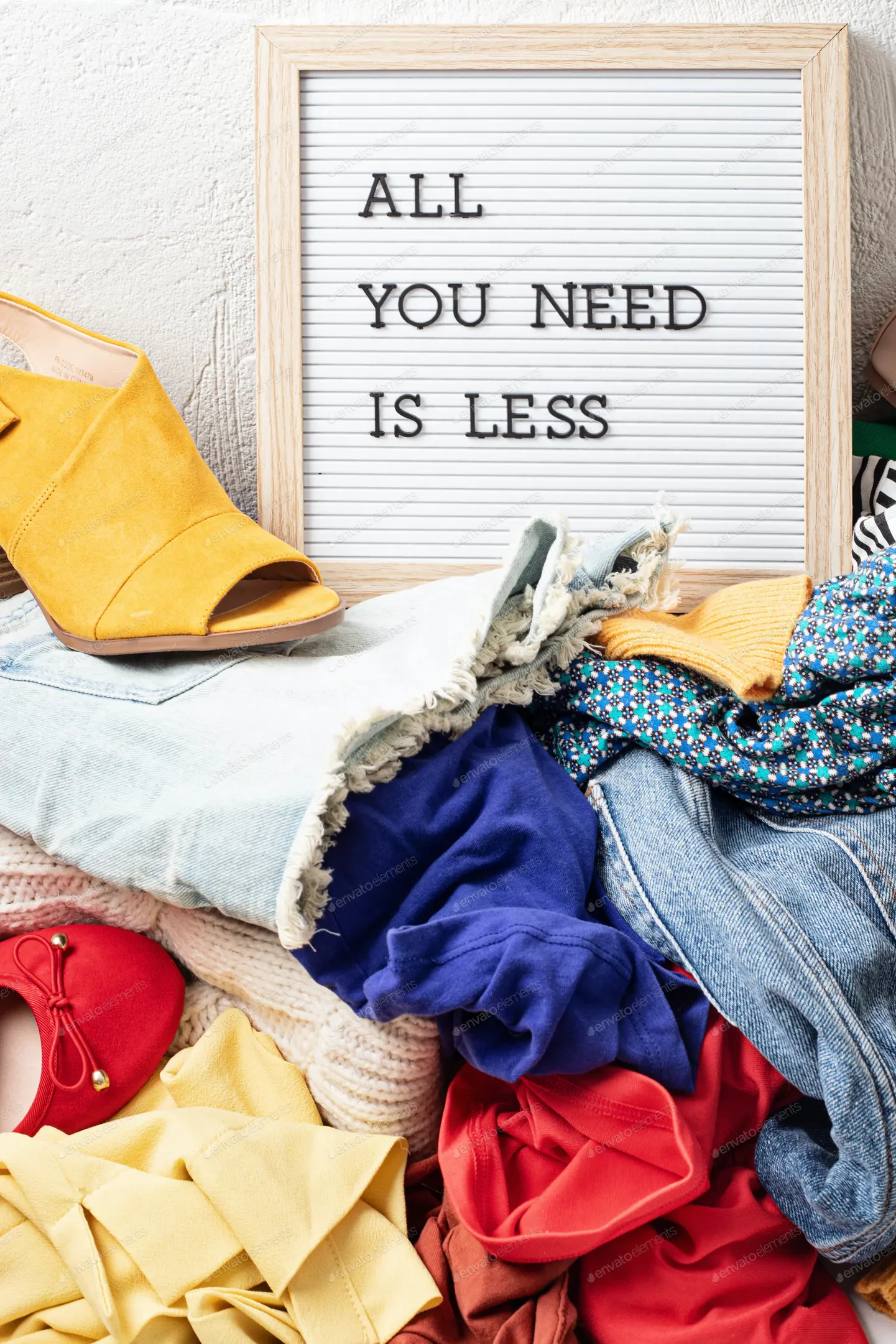
examples of stores in Luxembourg:
6) Rent & Swap
Renting clothes gives you the opportunity to wear something new without paying its full price. This is especially agreat idea when it comes to parties or rare occasions. Moreover, it’s important that we embrace the circular economy of renting clothes.
You could also swap clothes with friends or family members to participate in a happier fashion future. Ethical fashion is more than how the garment is made, it’s also about the idea of making clothes last, enjoying wearing these items and maximize its use to not end up in a landfill. Swapping clothes is great because what is old for you, is new to someone else and vice versa, creating happiness for the new wearers.
7) Change how you wash
To minimize microfiber pollution in the ocean and the air due to our synthetically made clothes, we can change the way we wash them:
8) Know where to buy:
The less we buy, the better, but if you really want to buy something or are searching for something in particular, it’s important to know where you could find these items ethically. There are many websites that highlight ethical brands and select them for their respect of these values.
Here are some great ones: WeDressFair, Happy New Green, SloWeAre, Goodonyou, Modetic, El Market, Dressing responsable,
9) Break up with Fast Fashion
Now that you’re more familiar with the existing alternatives, you might feel more encouraged
to start your ethical journey. The next step would be breaking up with Fast Fashion. Start by unfollowing their Instagram accounts and hitting that “unsubscribe” button at the end of their emails. Avoid going to their shops in town. The constant promotion of cheaply-made clothing that fills our social media and our streets has made mindful consuming harder, and cutting off that problem from its source is the best way to combat it.
By following these steps, we as consumers, would reduce emissions by more than half. And while all of these gestures seem small or insignificant, they end up making a huge difference.
Sources :
https://goodonyou.eco/5rs-of-fashion/
https://www.bbc.com/future/article/20200710-why-clothes-are-so-hard-to-recycle
https://www.muudana.com/mode-ethique-definition/
https://www.thegoodtrade.com/features/what-is-ethical-fashion
https://ethicalmadeeasy.com/what-is-ethical-fashion/
https://ethicalmadeeasy.com/3-ways-to-participate-in-ethical-fashion-when-you-can-hardly-pay-rent/
https://goodonyou.eco/what-to-do-about-microfibres/
https://www.commonobjective.co/article/faces-and-figures-who-makes-our-clothes